Book Review: The Origins and Evolution of Islamic Law
VerifiedAdded on 2020/04/01
|6
|1636
|41
Report
AI Summary
This report provides a detailed book review of Wael Hallaq's 'The Origins and Evolution of Islamic Law.' The review explores the formative years of Islamic law, focusing on the development of Sunni Islamic legal systems. It examines Hallaq's analysis of pre-Islamic influences, Quranic law, the emergence of legal ethics, the role of early judges, and the evolution of legal theories and schools. The review highlights Hallaq's challenges to Western scholars, his emphasis on the Hejaz, and his critique of other scholars' views on the evolution of Islamic law. It also discusses the book's strengths, such as its scholarly insights and detailed study of Islamic law, while also pointing out some problematic areas, like the limited scope to Sunni laws and the lack of detailed discussions on certain laws. Overall, the review emphasizes the book's contribution to understanding Islamic law's evolution and its significance for students and enthusiasts.
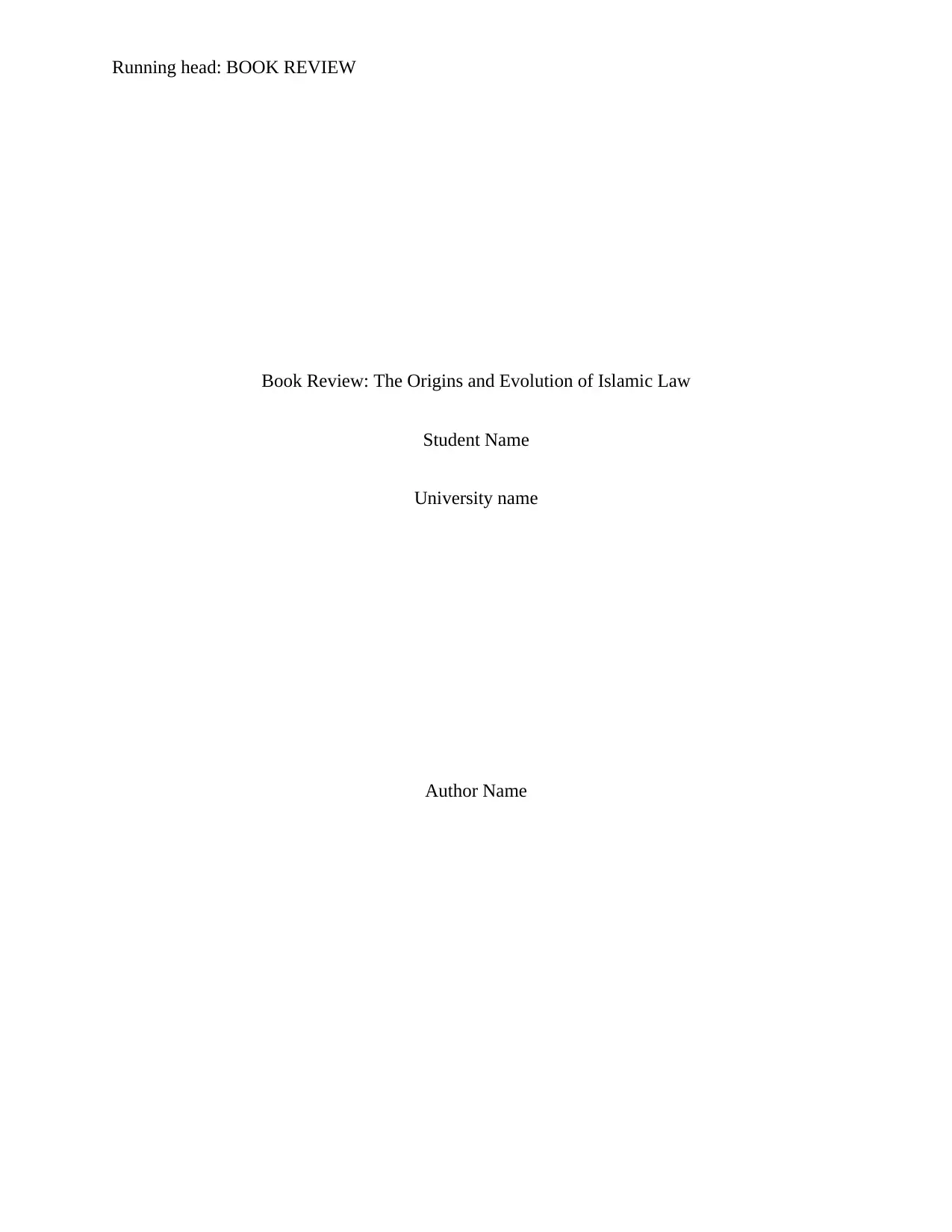
Running head: BOOK REVIEW
Book Review: The Origins and Evolution of Islamic Law
Student Name
University name
Author Name
Book Review: The Origins and Evolution of Islamic Law
Student Name
University name
Author Name
Paraphrase This Document
Need a fresh take? Get an instant paraphrase of this document with our AI Paraphraser
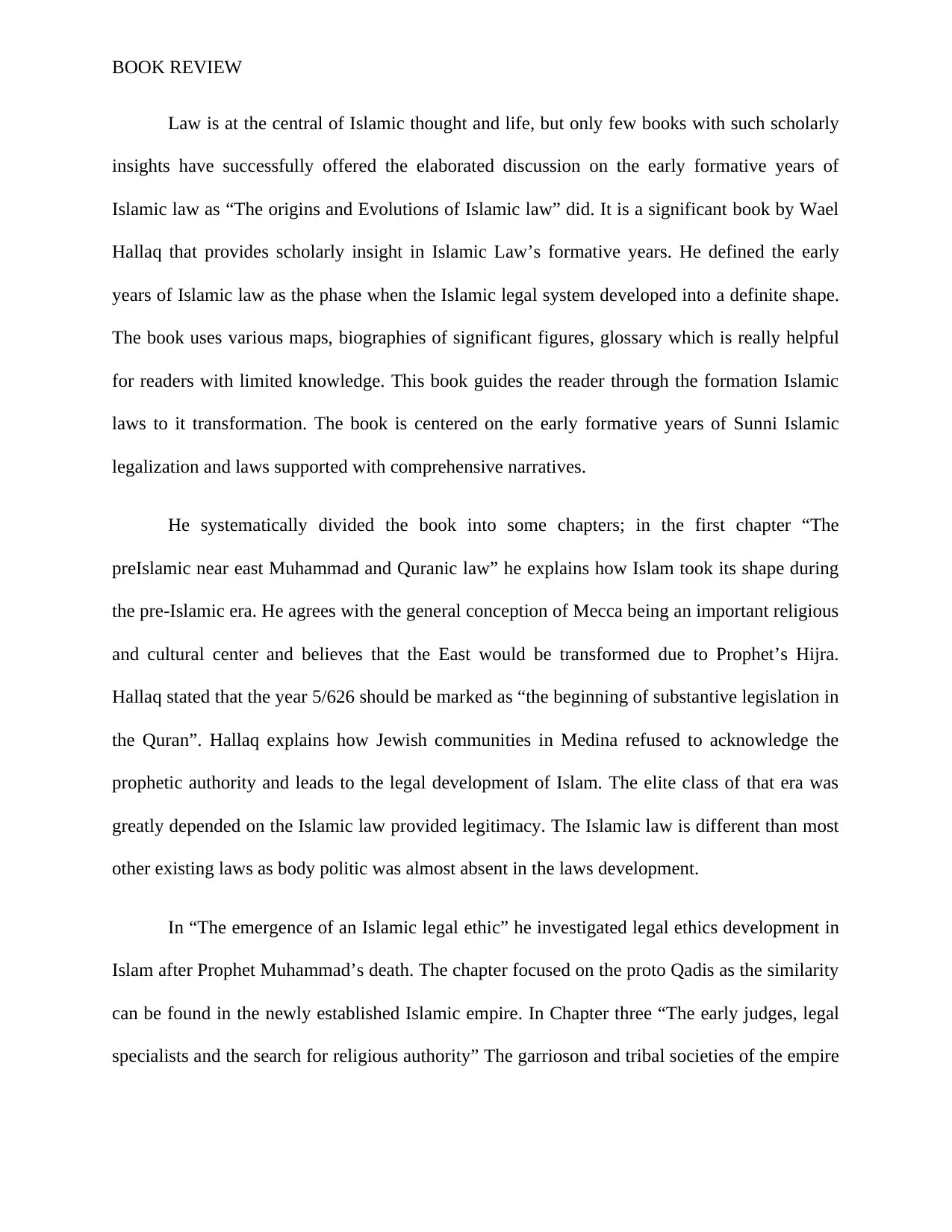
BOOK REVIEW
Law is at the central of Islamic thought and life, but only few books with such scholarly
insights have successfully offered the elaborated discussion on the early formative years of
Islamic law as “The origins and Evolutions of Islamic law” did. It is a significant book by Wael
Hallaq that provides scholarly insight in Islamic Law’s formative years. He defined the early
years of Islamic law as the phase when the Islamic legal system developed into a definite shape.
The book uses various maps, biographies of significant figures, glossary which is really helpful
for readers with limited knowledge. This book guides the reader through the formation Islamic
laws to it transformation. The book is centered on the early formative years of Sunni Islamic
legalization and laws supported with comprehensive narratives.
He systematically divided the book into some chapters; in the first chapter “The
preIslamic near east Muhammad and Quranic law” he explains how Islam took its shape during
the pre-Islamic era. He agrees with the general conception of Mecca being an important religious
and cultural center and believes that the East would be transformed due to Prophet’s Hijra.
Hallaq stated that the year 5/626 should be marked as “the beginning of substantive legislation in
the Quran”. Hallaq explains how Jewish communities in Medina refused to acknowledge the
prophetic authority and leads to the legal development of Islam. The elite class of that era was
greatly depended on the Islamic law provided legitimacy. The Islamic law is different than most
other existing laws as body politic was almost absent in the laws development.
In “The emergence of an Islamic legal ethic” he investigated legal ethics development in
Islam after Prophet Muhammad’s death. The chapter focused on the proto Qadis as the similarity
can be found in the newly established Islamic empire. In Chapter three “The early judges, legal
specialists and the search for religious authority” The garrioson and tribal societies of the empire
Law is at the central of Islamic thought and life, but only few books with such scholarly
insights have successfully offered the elaborated discussion on the early formative years of
Islamic law as “The origins and Evolutions of Islamic law” did. It is a significant book by Wael
Hallaq that provides scholarly insight in Islamic Law’s formative years. He defined the early
years of Islamic law as the phase when the Islamic legal system developed into a definite shape.
The book uses various maps, biographies of significant figures, glossary which is really helpful
for readers with limited knowledge. This book guides the reader through the formation Islamic
laws to it transformation. The book is centered on the early formative years of Sunni Islamic
legalization and laws supported with comprehensive narratives.
He systematically divided the book into some chapters; in the first chapter “The
preIslamic near east Muhammad and Quranic law” he explains how Islam took its shape during
the pre-Islamic era. He agrees with the general conception of Mecca being an important religious
and cultural center and believes that the East would be transformed due to Prophet’s Hijra.
Hallaq stated that the year 5/626 should be marked as “the beginning of substantive legislation in
the Quran”. Hallaq explains how Jewish communities in Medina refused to acknowledge the
prophetic authority and leads to the legal development of Islam. The elite class of that era was
greatly depended on the Islamic law provided legitimacy. The Islamic law is different than most
other existing laws as body politic was almost absent in the laws development.
In “The emergence of an Islamic legal ethic” he investigated legal ethics development in
Islam after Prophet Muhammad’s death. The chapter focused on the proto Qadis as the similarity
can be found in the newly established Islamic empire. In Chapter three “The early judges, legal
specialists and the search for religious authority” The garrioson and tribal societies of the empire
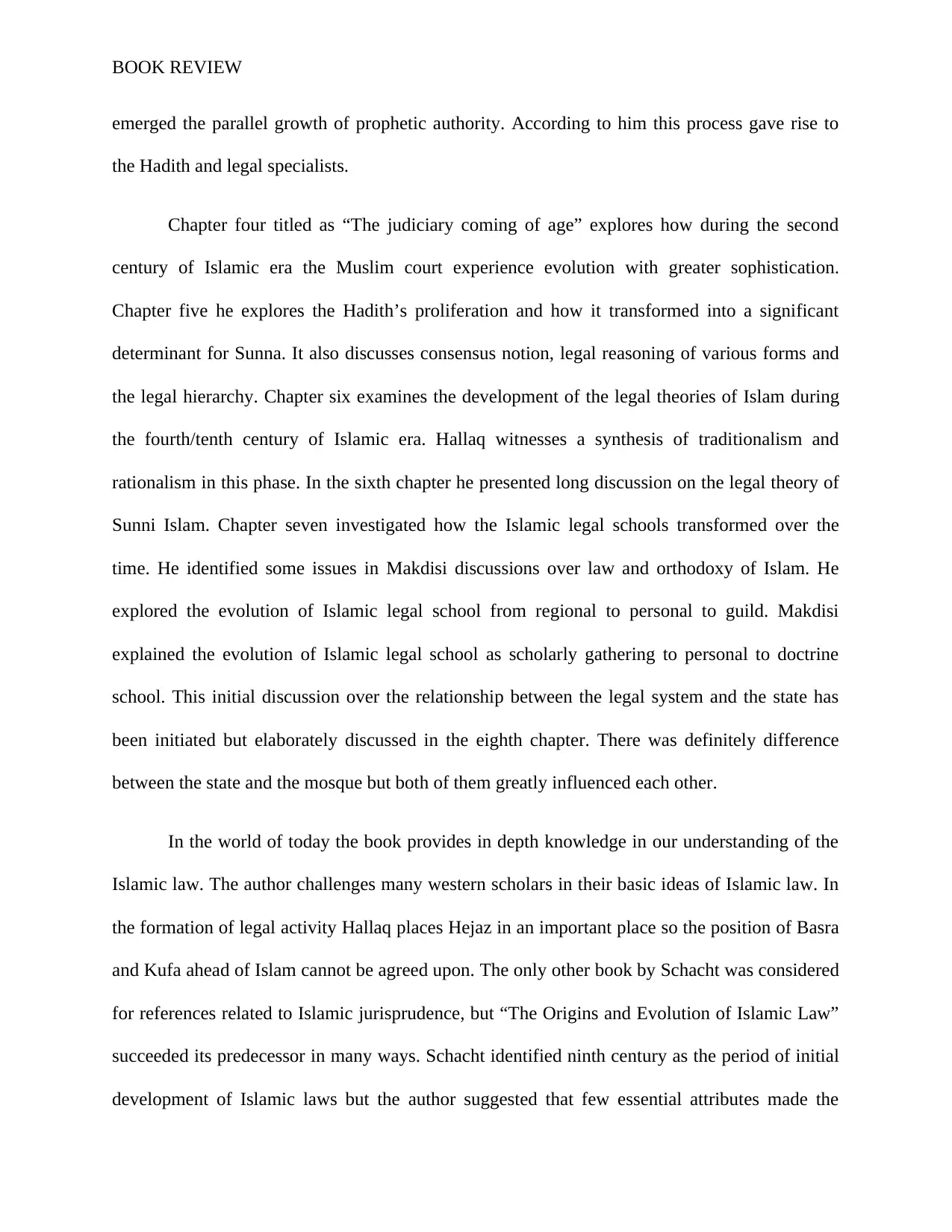
BOOK REVIEW
emerged the parallel growth of prophetic authority. According to him this process gave rise to
the Hadith and legal specialists.
Chapter four titled as “The judiciary coming of age” explores how during the second
century of Islamic era the Muslim court experience evolution with greater sophistication.
Chapter five he explores the Hadith’s proliferation and how it transformed into a significant
determinant for Sunna. It also discusses consensus notion, legal reasoning of various forms and
the legal hierarchy. Chapter six examines the development of the legal theories of Islam during
the fourth/tenth century of Islamic era. Hallaq witnesses a synthesis of traditionalism and
rationalism in this phase. In the sixth chapter he presented long discussion on the legal theory of
Sunni Islam. Chapter seven investigated how the Islamic legal schools transformed over the
time. He identified some issues in Makdisi discussions over law and orthodoxy of Islam. He
explored the evolution of Islamic legal school from regional to personal to guild. Makdisi
explained the evolution of Islamic legal school as scholarly gathering to personal to doctrine
school. This initial discussion over the relationship between the legal system and the state has
been initiated but elaborately discussed in the eighth chapter. There was definitely difference
between the state and the mosque but both of them greatly influenced each other.
In the world of today the book provides in depth knowledge in our understanding of the
Islamic law. The author challenges many western scholars in their basic ideas of Islamic law. In
the formation of legal activity Hallaq places Hejaz in an important place so the position of Basra
and Kufa ahead of Islam cannot be agreed upon. The only other book by Schacht was considered
for references related to Islamic jurisprudence, but “The Origins and Evolution of Islamic Law”
succeeded its predecessor in many ways. Schacht identified ninth century as the period of initial
development of Islamic laws but the author suggested that few essential attributes made the
emerged the parallel growth of prophetic authority. According to him this process gave rise to
the Hadith and legal specialists.
Chapter four titled as “The judiciary coming of age” explores how during the second
century of Islamic era the Muslim court experience evolution with greater sophistication.
Chapter five he explores the Hadith’s proliferation and how it transformed into a significant
determinant for Sunna. It also discusses consensus notion, legal reasoning of various forms and
the legal hierarchy. Chapter six examines the development of the legal theories of Islam during
the fourth/tenth century of Islamic era. Hallaq witnesses a synthesis of traditionalism and
rationalism in this phase. In the sixth chapter he presented long discussion on the legal theory of
Sunni Islam. Chapter seven investigated how the Islamic legal schools transformed over the
time. He identified some issues in Makdisi discussions over law and orthodoxy of Islam. He
explored the evolution of Islamic legal school from regional to personal to guild. Makdisi
explained the evolution of Islamic legal school as scholarly gathering to personal to doctrine
school. This initial discussion over the relationship between the legal system and the state has
been initiated but elaborately discussed in the eighth chapter. There was definitely difference
between the state and the mosque but both of them greatly influenced each other.
In the world of today the book provides in depth knowledge in our understanding of the
Islamic law. The author challenges many western scholars in their basic ideas of Islamic law. In
the formation of legal activity Hallaq places Hejaz in an important place so the position of Basra
and Kufa ahead of Islam cannot be agreed upon. The only other book by Schacht was considered
for references related to Islamic jurisprudence, but “The Origins and Evolution of Islamic Law”
succeeded its predecessor in many ways. Schacht identified ninth century as the period of initial
development of Islamic laws but the author suggested that few essential attributes made the
⊘ This is a preview!⊘
Do you want full access?
Subscribe today to unlock all pages.

Trusted by 1+ million students worldwide
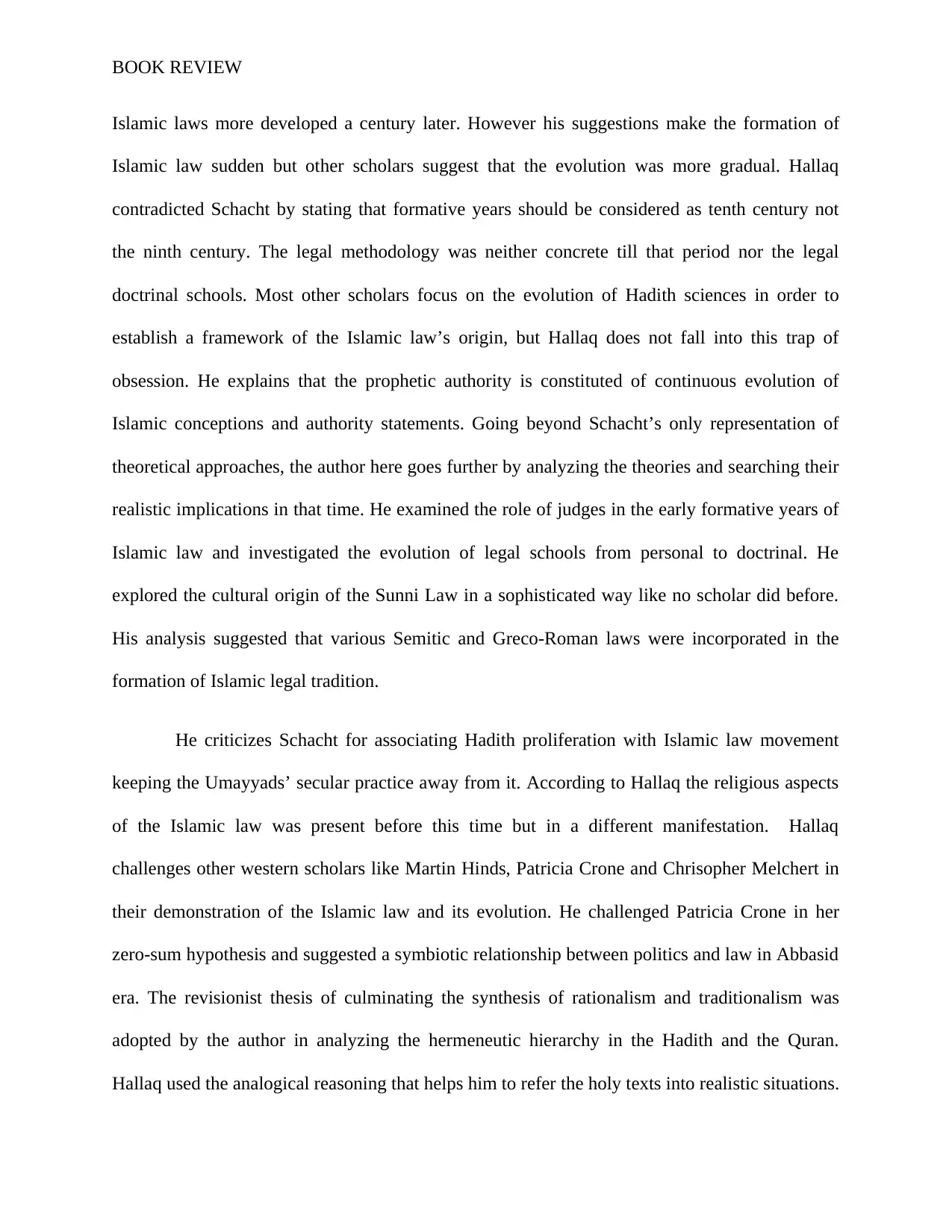
BOOK REVIEW
Islamic laws more developed a century later. However his suggestions make the formation of
Islamic law sudden but other scholars suggest that the evolution was more gradual. Hallaq
contradicted Schacht by stating that formative years should be considered as tenth century not
the ninth century. The legal methodology was neither concrete till that period nor the legal
doctrinal schools. Most other scholars focus on the evolution of Hadith sciences in order to
establish a framework of the Islamic law’s origin, but Hallaq does not fall into this trap of
obsession. He explains that the prophetic authority is constituted of continuous evolution of
Islamic conceptions and authority statements. Going beyond Schacht’s only representation of
theoretical approaches, the author here goes further by analyzing the theories and searching their
realistic implications in that time. He examined the role of judges in the early formative years of
Islamic law and investigated the evolution of legal schools from personal to doctrinal. He
explored the cultural origin of the Sunni Law in a sophisticated way like no scholar did before.
His analysis suggested that various Semitic and Greco-Roman laws were incorporated in the
formation of Islamic legal tradition.
He criticizes Schacht for associating Hadith proliferation with Islamic law movement
keeping the Umayyads’ secular practice away from it. According to Hallaq the religious aspects
of the Islamic law was present before this time but in a different manifestation. Hallaq
challenges other western scholars like Martin Hinds, Patricia Crone and Chrisopher Melchert in
their demonstration of the Islamic law and its evolution. He challenged Patricia Crone in her
zero-sum hypothesis and suggested a symbiotic relationship between politics and law in Abbasid
era. The revisionist thesis of culminating the synthesis of rationalism and traditionalism was
adopted by the author in analyzing the hermeneutic hierarchy in the Hadith and the Quran.
Hallaq used the analogical reasoning that helps him to refer the holy texts into realistic situations.
Islamic laws more developed a century later. However his suggestions make the formation of
Islamic law sudden but other scholars suggest that the evolution was more gradual. Hallaq
contradicted Schacht by stating that formative years should be considered as tenth century not
the ninth century. The legal methodology was neither concrete till that period nor the legal
doctrinal schools. Most other scholars focus on the evolution of Hadith sciences in order to
establish a framework of the Islamic law’s origin, but Hallaq does not fall into this trap of
obsession. He explains that the prophetic authority is constituted of continuous evolution of
Islamic conceptions and authority statements. Going beyond Schacht’s only representation of
theoretical approaches, the author here goes further by analyzing the theories and searching their
realistic implications in that time. He examined the role of judges in the early formative years of
Islamic law and investigated the evolution of legal schools from personal to doctrinal. He
explored the cultural origin of the Sunni Law in a sophisticated way like no scholar did before.
His analysis suggested that various Semitic and Greco-Roman laws were incorporated in the
formation of Islamic legal tradition.
He criticizes Schacht for associating Hadith proliferation with Islamic law movement
keeping the Umayyads’ secular practice away from it. According to Hallaq the religious aspects
of the Islamic law was present before this time but in a different manifestation. Hallaq
challenges other western scholars like Martin Hinds, Patricia Crone and Chrisopher Melchert in
their demonstration of the Islamic law and its evolution. He challenged Patricia Crone in her
zero-sum hypothesis and suggested a symbiotic relationship between politics and law in Abbasid
era. The revisionist thesis of culminating the synthesis of rationalism and traditionalism was
adopted by the author in analyzing the hermeneutic hierarchy in the Hadith and the Quran.
Hallaq used the analogical reasoning that helps him to refer the holy texts into realistic situations.
Paraphrase This Document
Need a fresh take? Get an instant paraphrase of this document with our AI Paraphraser
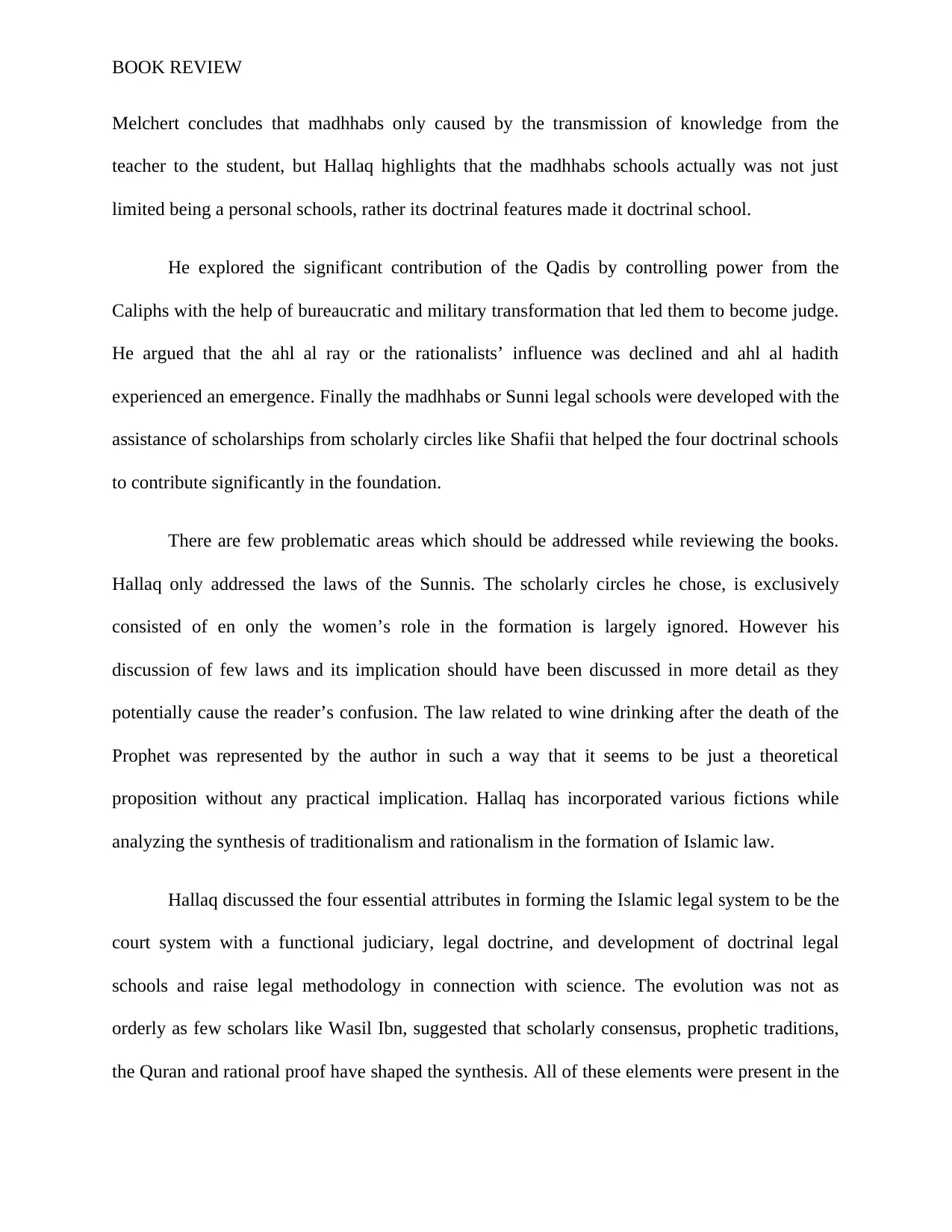
BOOK REVIEW
Melchert concludes that madhhabs only caused by the transmission of knowledge from the
teacher to the student, but Hallaq highlights that the madhhabs schools actually was not just
limited being a personal schools, rather its doctrinal features made it doctrinal school.
He explored the significant contribution of the Qadis by controlling power from the
Caliphs with the help of bureaucratic and military transformation that led them to become judge.
He argued that the ahl al ray or the rationalists’ influence was declined and ahl al hadith
experienced an emergence. Finally the madhhabs or Sunni legal schools were developed with the
assistance of scholarships from scholarly circles like Shafii that helped the four doctrinal schools
to contribute significantly in the foundation.
There are few problematic areas which should be addressed while reviewing the books.
Hallaq only addressed the laws of the Sunnis. The scholarly circles he chose, is exclusively
consisted of en only the women’s role in the formation is largely ignored. However his
discussion of few laws and its implication should have been discussed in more detail as they
potentially cause the reader’s confusion. The law related to wine drinking after the death of the
Prophet was represented by the author in such a way that it seems to be just a theoretical
proposition without any practical implication. Hallaq has incorporated various fictions while
analyzing the synthesis of traditionalism and rationalism in the formation of Islamic law.
Hallaq discussed the four essential attributes in forming the Islamic legal system to be the
court system with a functional judiciary, legal doctrine, and development of doctrinal legal
schools and raise legal methodology in connection with science. The evolution was not as
orderly as few scholars like Wasil Ibn, suggested that scholarly consensus, prophetic traditions,
the Quran and rational proof have shaped the synthesis. All of these elements were present in the
Melchert concludes that madhhabs only caused by the transmission of knowledge from the
teacher to the student, but Hallaq highlights that the madhhabs schools actually was not just
limited being a personal schools, rather its doctrinal features made it doctrinal school.
He explored the significant contribution of the Qadis by controlling power from the
Caliphs with the help of bureaucratic and military transformation that led them to become judge.
He argued that the ahl al ray or the rationalists’ influence was declined and ahl al hadith
experienced an emergence. Finally the madhhabs or Sunni legal schools were developed with the
assistance of scholarships from scholarly circles like Shafii that helped the four doctrinal schools
to contribute significantly in the foundation.
There are few problematic areas which should be addressed while reviewing the books.
Hallaq only addressed the laws of the Sunnis. The scholarly circles he chose, is exclusively
consisted of en only the women’s role in the formation is largely ignored. However his
discussion of few laws and its implication should have been discussed in more detail as they
potentially cause the reader’s confusion. The law related to wine drinking after the death of the
Prophet was represented by the author in such a way that it seems to be just a theoretical
proposition without any practical implication. Hallaq has incorporated various fictions while
analyzing the synthesis of traditionalism and rationalism in the formation of Islamic law.
Hallaq discussed the four essential attributes in forming the Islamic legal system to be the
court system with a functional judiciary, legal doctrine, and development of doctrinal legal
schools and raise legal methodology in connection with science. The evolution was not as
orderly as few scholars like Wasil Ibn, suggested that scholarly consensus, prophetic traditions,
the Quran and rational proof have shaped the synthesis. All of these elements were present in the
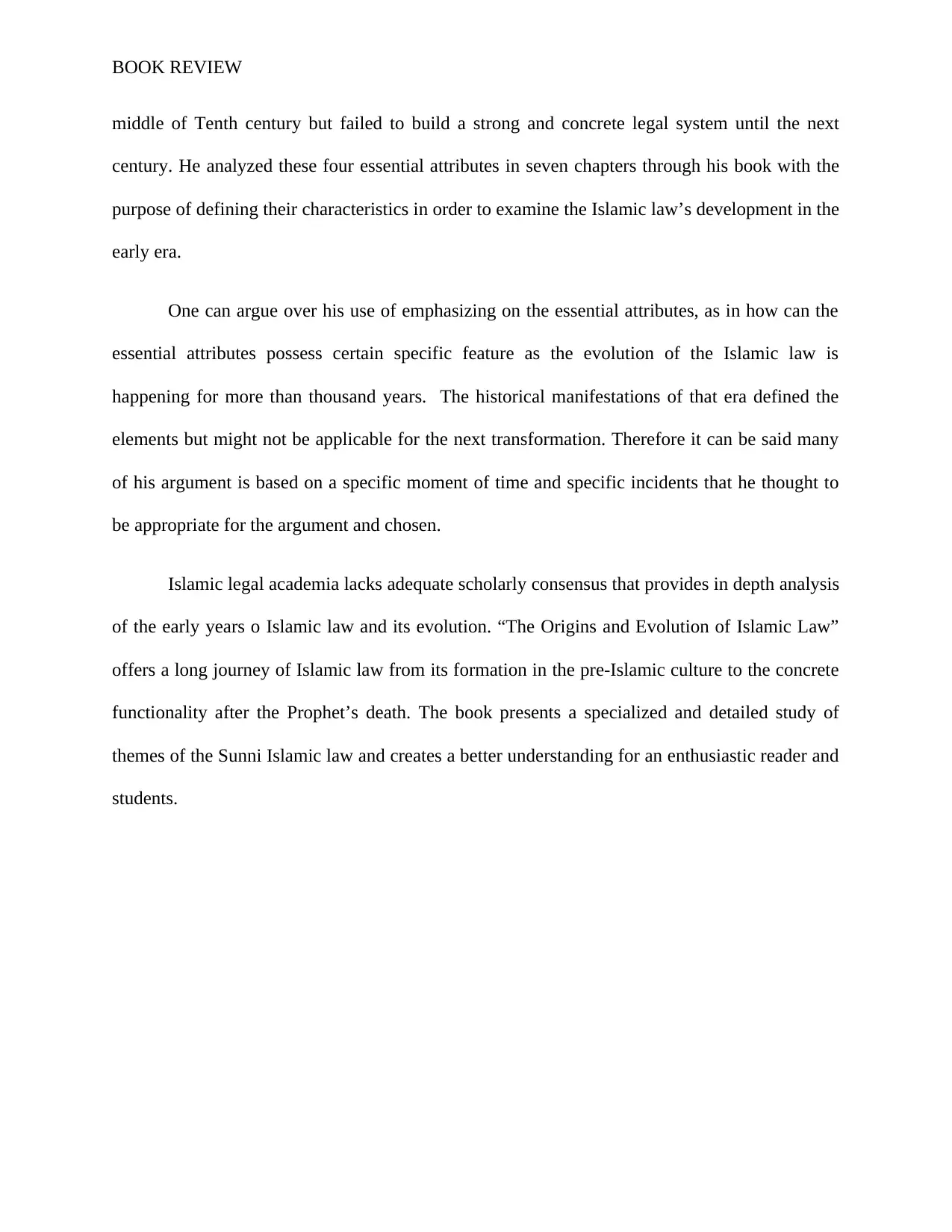
BOOK REVIEW
middle of Tenth century but failed to build a strong and concrete legal system until the next
century. He analyzed these four essential attributes in seven chapters through his book with the
purpose of defining their characteristics in order to examine the Islamic law’s development in the
early era.
One can argue over his use of emphasizing on the essential attributes, as in how can the
essential attributes possess certain specific feature as the evolution of the Islamic law is
happening for more than thousand years. The historical manifestations of that era defined the
elements but might not be applicable for the next transformation. Therefore it can be said many
of his argument is based on a specific moment of time and specific incidents that he thought to
be appropriate for the argument and chosen.
Islamic legal academia lacks adequate scholarly consensus that provides in depth analysis
of the early years o Islamic law and its evolution. “The Origins and Evolution of Islamic Law”
offers a long journey of Islamic law from its formation in the pre-Islamic culture to the concrete
functionality after the Prophet’s death. The book presents a specialized and detailed study of
themes of the Sunni Islamic law and creates a better understanding for an enthusiastic reader and
students.
middle of Tenth century but failed to build a strong and concrete legal system until the next
century. He analyzed these four essential attributes in seven chapters through his book with the
purpose of defining their characteristics in order to examine the Islamic law’s development in the
early era.
One can argue over his use of emphasizing on the essential attributes, as in how can the
essential attributes possess certain specific feature as the evolution of the Islamic law is
happening for more than thousand years. The historical manifestations of that era defined the
elements but might not be applicable for the next transformation. Therefore it can be said many
of his argument is based on a specific moment of time and specific incidents that he thought to
be appropriate for the argument and chosen.
Islamic legal academia lacks adequate scholarly consensus that provides in depth analysis
of the early years o Islamic law and its evolution. “The Origins and Evolution of Islamic Law”
offers a long journey of Islamic law from its formation in the pre-Islamic culture to the concrete
functionality after the Prophet’s death. The book presents a specialized and detailed study of
themes of the Sunni Islamic law and creates a better understanding for an enthusiastic reader and
students.
⊘ This is a preview!⊘
Do you want full access?
Subscribe today to unlock all pages.

Trusted by 1+ million students worldwide
1 out of 6
Your All-in-One AI-Powered Toolkit for Academic Success.
+13062052269
info@desklib.com
Available 24*7 on WhatsApp / Email
![[object Object]](/_next/static/media/star-bottom.7253800d.svg)
Unlock your academic potential
Copyright © 2020–2025 A2Z Services. All Rights Reserved. Developed and managed by ZUCOL.
